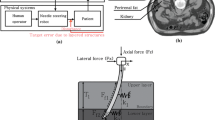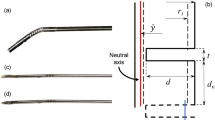Abstract
During the process of percutaneous puncture, a medical needle with a beveled tip is usually inserted into a multilayered soft tissue, which contains a muscle layer, before it reaches the target. The robot-assisted needle insertion technology will help brachytherapists to perform high-accuracy seed implantation. To guide the automatic needle insertion, a mechanics-based model to simulate needle deflection caused by the asymmetric cutting force during insertion in the muscle-contained double-layered tissue is developed. The model is driven by the anisotropic and inhomogeneous interaction forces, which are updated off-line according to the tip’s position and pose and are independent of the real-time data feedback. The parameterized insertion orientation angle and 180° axial rotation are introduced in the simulating process as the control inputs of the needle to adjust the needle deflection. Simulations and experiments confirm that the cooperative control of the insertion orientation angle and 180° axial rotation can steer the needle towards to any desired target in the reachable region of the tip. The results show that the proposed approach can successfully predict the needle deflection in the muscle-contained double-layered tissue. This work will be useful for a needle automatic control strategy design.

Graphical abstract









Similar content being viewed by others
References
Abolhassani N, Patel R, Ayazi F (2007) Needle control along desired tracks in robotic prostate brachytherapy. IEEE International Conference on Systems, Man and Cybernetics, pp 3361–3366
Barnett AC, Lee YS, Moore JZ (2016) Fracture mechanics model of needle cutting tissue. J Manuf Sci E-T ASME 138:011005
Bischoff JE, Arruda EM, Grosh K (2004) A rheological network model for the continuum anisotropic and viscoelastic behavior of soft tissue. Biomech Model Mechan 3:56–65
Blumenfeld P, Hata N, DiMaio S, Zou K, Haker S, Fichtinger G, Tempany C (2007) Transperineal prostate biopsy under magnetic resonance image guidance: a needle placement accuracy study. J Magn Reson Imaging 26(3):688–694
Böl M, Ehret AE, Leichsenring K, Weichert C, Kruse R (2014) On the anisotropy of skeletal muscle tissue under compression. Acta Biomater 10:3225–3234
Böl M, Kruse R, Ehret AE, Leichsenring K, Siebert T (2012) Compressive properties of passive skeletal muscle-the impact of precise sample geometry on parameter identification in inverse finite element analysis. J Biomech 45:2673–2679
Buzurovic I, Podder T, Yan K, Hu Y, Valicenti R, Dicker A, Yu Y (2008) Parameter optimization for brachytherapy robotic needle insertion and seed deposition. Med Phys 35:2865
Buzurovic IM, Salinic S, Orio PF, Nguyen PL, Cormack RA (2017) A novel approach to an automated needle insertion in brachytherapy procedures. Med Biol Eng Comput 55:1–15
Cowin SC (2013) Continuum mechanics of anisotropic materials. Springer, New York, pp 83–99
Feng Y, Lee CH, Sun L, Okamoto RJ, Ji S (2015) Automated estimation of elastic material parameters of a transversely isotropic material using asymmetric indentation and inverse finite element analysis. ASME 2015 International Mechanical Engineering Congress and Exposition, pp V003T03A007
Gerwen DJV, Dankelman J, Dobbelsteen JJVD (2012) Needle-tissue interaction forces--a survey of experimental data. Med Eng Phys 34:665–680
Hing JT, Brooks AD, Desai JP (2006) Reality-based needle insertion simulation for haptic feedback in prostate brachytherapy. IEEE International Conference on Robotics and Automation, pp 619-624
Jiang S, Wang X (2016) Mechanics-based interactive modeling for medical flexible needle insertion in consideration of nonlinear factors. J Comput Nonlin Dyn 11:011004-1–011004-01100411
Keleekai N, Schuster C, Murray C, King M, Stahl B, Labrozzi L, LeClair M, Glover K (2016) Improving nurses’ peripheral intravenous catheter insertion knowledge, confidence, and skills using a simulation-based blended learning program: a randomized trial. Sim Healthc 11(6):376–384
Khadem M, Fallahi B, Rossa C, Sloboda RS (2015) A mechanics-based model for simulation and control of flexible needle insertion in soft tissue. IEEE International Conference on Robotics and Automation, pp 2264-2269
Khadem M, Rossa C, Sloboda R, Usmani N, Tavakoli M (2016) Mechanics of tissue cutting during needle insertion in biological tissue. IEEE Rob Aut Let 1:800–807
Khadem M, Rossa C, Sloboda RS, Usmani N, Tavakoli M (2016) Ultrasound-guided model predictive control of needle steering in biological tissue. J Med Rob Res 01:1640007
Lee H, Kim J (2014) Estimation of flexible needle deflection in layered soft tissues with different elastic moduli. Med Biol Eng Comput 52:729–740
Lehmann T, Rossa C, Usmani N, Sloboda R, Tavakoli M. (2016). A real-time estimator for needle deflection during insertion into soft tissue based on adaptive modeling of needle-tissue interactions. IEEE/ASME Transactions on Mechatronics, 1-1
Lehmann T, Rossa C, Usmani N, Sloboda R, Tavakoli M (2017) Deflection modeling for a needle actuated by lateral force and axial rotation during insertion in soft phantom tissue. Mechatronics 48:43–52
Lewis MC, Lafferty JP, Sacks MS, Pallares VS, Terriet M (2000) How much work is required to puncture dura with tuohy needles? Brit J Anaesth 85:238–241
Loukas C, Nikiteas N, Kanakis M, Georgiou E (2011) Evaluating the effectiveness of virtual reality simulation training in intravenous cannulation. Sim Healthc 6(4):213–217
Meltsner MA, Ferrier NJ, Thomadsen BR (2007) Observations on rotating needle insertions using a brachytherapy robot. Phys Med Biol 52:6027–6037
Moreira P, Misra S (2015) Biomechanics-based curvature estimation for ultrasound-guided flexible needle steering in biological tissues. Ann Biomed Eng 43:1716–1726
Morrow DA, Donahue TLH, Odegard GM, Kaufman KR (2010) Transversely isotropic tensile material properties of skeletal muscle tissue. J Mech Behav Biomed 3:124–129
Okamura AM, Simone C, Leary M (2004) Force modeling for needle insertion into soft tissue. IEEE Trans Biomed Eng 51:1707–1716
Roesthuis RJ, Abayazid M, Misra S (2012) Mechanics-based model for predicting in-plane needle deflection with multiple bends. The 4th IEEE RAS/EMBS International Conference on Biomedical Robotics and Biomechatronics, 49: 69-74
Roesthuis RJ, Veen YRJV, Jahya A, Misra S (2011) Mechanics of needle-tissue interaction. IEEE/RSJ International Conference on Intelligent Robots and Systems 32:2557–2563
Rossa C, Khadem M, Sloboda R, Usmani N, Tavakoli M (2016) Adaptive quasi-static modelling of needle deflection during steering in soft tissue. IEEE Rob Aut Let 1:916–923
Rossa C, Lehmann T, Sloboda R, Usmani N, Tavakoli MC (2017) A data-driven soft sensor for needle deflection in heterogeneous tissue using just-in-time modelling. Med Biol Eng Comput 55:1401–1414
Rossa C, Tavakoli M (2017) Issues in closed-loop needle steering. Control Eng Pract 62:55–69
Ruvolo EC Jr, Stamatas GN, Kollias N (2007) Skin viscoelasticity displays site- and age-dependent angular anisotropy. Skin Pharmacol Physiol 20:313–321
Taschereau R, Pouliot J, Roy J, Tremblay D (2000) Seed misplacement and stabilizing needles in transperineal permanent prostate implants. Radiother Oncol 55(1):59–63
Vrooijink G, Abayazid M, Patil S, Alterovitz R, Misra S (2014) Needle path planning and steering in a three-dimensional non-static environment using two-dimensional ultrasound images. Int J Robot Res 33(10):1361–1374
Wang X, Jiang S (2016) Study of the targeting error for percutaneous needle insertion into soft phantom material. J Mech Med Biol 16:413–431
Yan K, Yu Y, Xiao D, Podder T, Buzurovic I, Hu Y et al (2008) Flexible needle-tissue interaction modelling using depth-varying mean parameter. HKIE Transactions 15:17–28. https://doi.org/10.1080/1023697X.2008.10668128
Funding
This work was supported by the National Natural Science Foundation of China (No. 51775368 and No. 51811530310).
Author information
Authors and Affiliations
Corresponding author
Additional information
Publisher’s note
Springer Nature remains neutral with regard to jurisdictional claims in published maps and institutional affiliations.
Rights and permissions
About this article
Cite this article
Liu, W., Yang, Z., Fang, P. et al. Deflection simulation for a needle adjusted by the insertion orientation angle and axial rotation during insertion in the muscle-contained double-layered tissue. Med Biol Eng Comput 58, 2291–2304 (2020). https://doi.org/10.1007/s11517-020-02212-x
Received:
Accepted:
Published:
Issue Date:
DOI: https://doi.org/10.1007/s11517-020-02212-x




